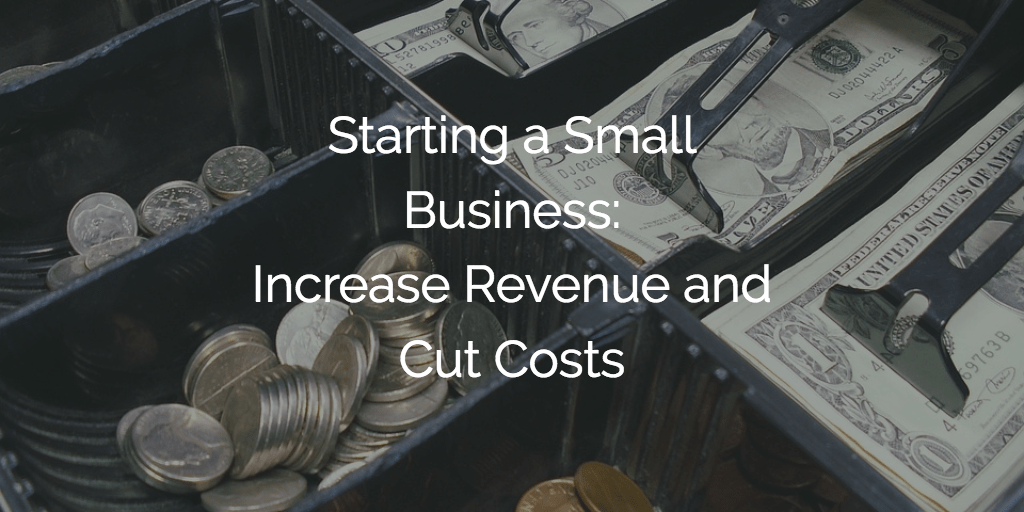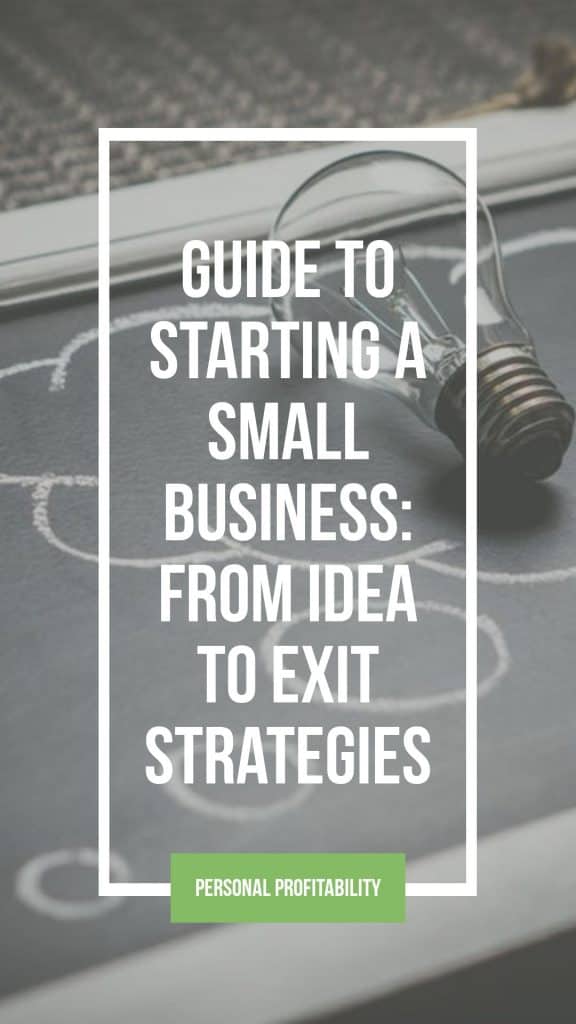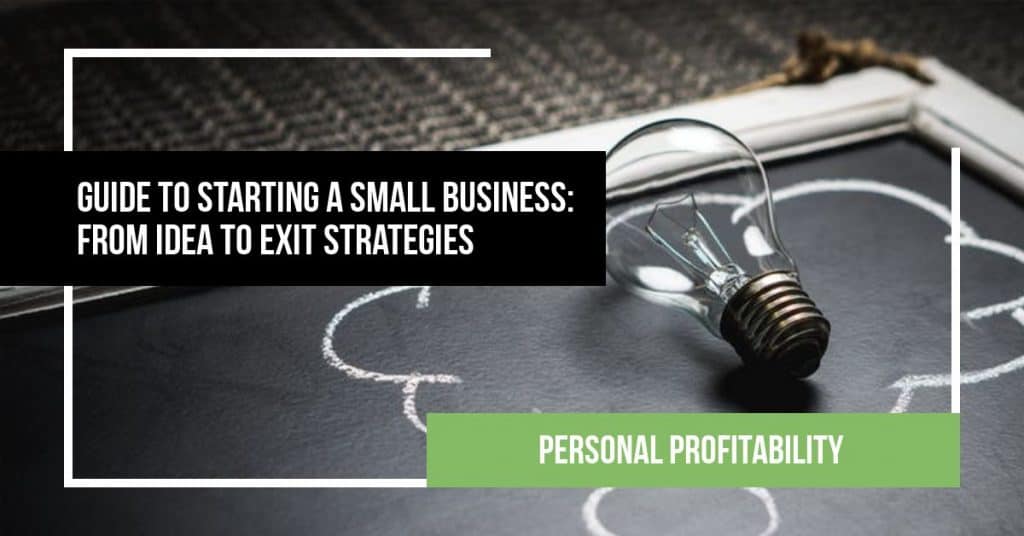The goal of many people around the world is to own their own business. Just like many of you, I dream of being my own boss. I wish I could set my own hours. I would love to work independently and make a living on my own. While we may have the dream, few of us have a formal business education or know enough about entrepreneurship to dive in and move through the process of starting a business. Read further to learn about starting a small business: from idea to exit strategy.
Fortunately for all of you, I know quite a bit about starting and operating a small business. I grew up around a family-owned video store operated by my parents in Aurora, Colorado. On several occasions, I was in charge of operations. I even came in to run the store when I was ten years old as our computer system failed on a busy day while my parents were on a cruise in Alaska. In the days before cell phones, they were not reachable. I just did what I had to do. I have also managed a small retail operation for the Boy Scouts.
I have started a few different business ventures in my life. Those include a bracelet selling operation and a rap group, in addition to a few web projects, all of which have at least broken even. During college, I spent nine months as an intern with a financial consulting company in Boulder, Colorado. I was generally focused on small business growth projects.
If my hands-on experience has not convinced you that I can talk about small business, I have spent six years in the classroom learning about business. I have an undergraduate finance degree and an MBA in finance. Along with taking multiple business law classes, finance classes, and marketing classes that have focused on small businesses.
Over the next couple of weeks, we are going to cover a range of topics designed to bring your small business to life. We are going to look at finding an idea, building a business plan, testing and market research, opening your doors (or office or website), increasing revenues and cutting costs, finding investors for quick growth, and making a big exit.
Of course, this model will not be an exact fit for every type of business, however, it will give you a good idea of how to move forward and start making money on your own. Whether you are looking to work from home, open a multi-employee service business, or start a multi-national corporation, this series will take you through the most important steps of building a sustainable company.
Starting a Small Business: The Idea

One of the hardest parts of starting a business is coming up with a good idea and taking the first steps to bring your idea to reality. An idea can range from a new product or service to an improvement on a current business to a common business such as web sales or a restaurant.
There are no rules on what can or can’t be a business, other than the laws of the countries you plan to operate it. The only real rule is finding a business that customers would actually spend money for. If you are the only one that would buy your product, it is a bad product.
The key to a successful product is fulfilling a want or a need. I know that sounds pretty basic, but it really is that simple. If you have ever thought, “this would be so much easier if I only had ____,” you have come up with a business idea. If you want to sell it to more people than your mom, though, it must be a common problem.
It is common for entrepreneurs to have an idea book. An idea book can be a notepad, a journal, a computer file, or a series of sticky notes. Just write something down each time you think of a want or need. Remember that everything from the Ford Model T to Google started as a simple idea.
Trying to come up with an idea is a much harder prospect. You can easily search the Internet for business ideas, but most are going to be franchise opportunities. If you want to own a franchise, it is fairly easy to find a franchise company and get started. Just search online to find franchise opportunities ranging from fast food and retail brick-and-mortar businesses to tax preparation and bookkeeping, which can be done from home.
Coming up with a new idea is much harder, though. Many new ideas require funding and hard work to get started (stay tuned for an article on raising capital later in the series). If you do come up with an idea, you have to be sure people are willing to pay you and that you can actually do it (there will be articles about that too).
The real key here is creativity. Think outside the box. Who would have ever guessed that millions of people would buy a Pet Rock, Beanie Baby, or Tamagotchi? Those silly trends made millions of dollars. Someone saw into the future and created Amazon and Netflix. Other entrepreneurs created Wikipedia and Mint.com. Each of those $1 per download iPhone apps and many Facebook applications generates enough money to live on. The 4 Hour Work Week, by Tim Ferris, describes a great money-making idea as a “muse.” A muse can really be anything.
Keep your notepad handy and write ideas as they come. Abraham Lincoln failed twelve times in his career before he became one of the best-remembered presidents in United States history, but that didn’t stop him. Businesses fail for all sorts of reasons. The trick is to keep working on an idea until you get one that works. Never give up.
Starting a Small Business: Why Write a Business Plan?

This section comes from guest author Aaron Pinkston at Clarifinancial.
When Eric asked me to write something about the business plan, he probably thought I would write “How to Write a Business Plan.” But there are a few problems with that:
- It’s boring. (Telling someone what to do is dull. Exploring deep purpose and divining a form – that makes sparks.)
- It’s been done. (If you want to know what to include, ask around or do an online search.)
- It will change. (Depending on what you’re trying to accomplish or the latest business fad, it will be different in the future.)
The reality is the business plan you write will be different for your industry, current trends, and reason for writing it in the first place. If you need guidance about business plan trends, look for cheap or free entrepreneurial resources near you. If you need help with your industry, consider if you have the expertise the business requires.
The big thing that makes writing a business plan different in different situations is the “why” behind it all. Figuring out why you’re writing a business plan and how that impacts it is probably the most important thing of all. Generally, you’re either trying to hash out an idea or explain something, or you’re trying to sell somebody on the idea or get money.
Exploring the Stapleclip
If you just came up with the best type of paperclip ever that combines the benefits of a paperclip and a staple, a “stapleclip” of sorts, you might wonder how you could make money from this invention. Some people believe once they come up with the perfect idea, the rest falls into place, but without a plan of action and (more importantly) action itself, the idea is worthless. Working out a business plan (or two or three) around your invention could help you organize your thoughts and figure out the best method of monetizing the stapleclip.
Should you license the stapleclip or manufacture it? How much are your legal fees at each stage if you license it? Can you afford to and are you willing to defend the patent against established corporations? If you manufacture the staple clip, who will distribute it? You could discover inventing the stapleclip was the easy part for you, meaning you need outside help – from where, from who, what kind?
In this case, the reason you want to write the business plan is to explore ideas. You’re not ready to firm everything up, but the business plan is a useful way to document your learning, find different pathways, and identify holes in the stapleclip business. Don’t worry about formality here. Just get it down on paper, expand, find problems, fix things, talk to experts, find some research, and clarify. Then you might be ready to move on to another stage – or not, but it’s better to find out on paper first.
Describing Landscaping
Likewise, you might run a large landscaping business and need to explain to your new managers the big idea that makes your horticulture and business methods unique. Formalizing your thoughts in a business plan, even a short one, could be a valuable way to do this.
Now, I know folks in the landscaping business aren’t the bookwormi-est bunch, but that doesn’t mean they can’t get value out of your plans. Keep it short, include lots of charts and graphs. And when you think you’re done, the hard part will start. Cut it in half.
If you’re trying to explain some lofty ideas and convey differentiation and procedures in a way that people will comprehend easily and not fall asleep during, editing is critical. When in doubt, cut it out. Try to cut the size of your business plan in half. Even if you can’t, the exercise will be good for creating concise ideas with a concrete punch.
We all think our own ideas are the best! But trust me, to people outside your own head, cutting the jungle of words down with the machete of editing will be like a shot of caffeine. Too much chocolate pudding is a bad thing. Make your words like sharks with laser beams on their head and people will pay attention.
Money for Star-Shaped Signs
Okay, but what if you’re writing a business plan to get a business loan or attract investors? Your words will be worth money. Notice you can have a great business idea and a solid sense of execution, but if your words don’t back it up, you won’t get the money you need.
Let’s say you flipped signs on street corners for years and noticed people really respond well to star-shaped signs better than the old-fashioned arrows. You have a few local businesses signed up for star-shaped sign flipping, but you need to expand to see profitability because the star shape requires more expensive materials. Expect to have to quantify the increased response rate to stars vs. arrows. Independent research would be preferable, but statistically significant raw data would help too (hint: This would also help sell your service to business owners.)
Don’t forget, you have something called a two-sided market in this case: the people who respond to star-shaped signs and the business owners. Make sure to talk about why both audiences will be attracted to your business, what will keep others from adopting the star shape for their signs, etc. Get specific, and then cut it down to size.
When you are writing the rough draft of your business plan, keep the general layout in mind, but don’t sweat too much about it. What makes your business unique will also dictate an emphasis on certain parts. Only after you have written it out the first time, take note of the specific requirements of the plan design. If your business plan is supposed to be under 15 pages and you wrote 30 the first time around, the good news is it will be information-dense. If you are thin in one area, now is the time to do some research and expand on that piece.
Expect to go through at least two edits. When you think you’re done, get feedback from business coaches, advisors, colleagues in the business, and so on. If they tell you they really like it without making comments, tell them to do you a favor and read it again to help you make it better. Nobody’s perfect out of the gate, and you shouldn’t expect to be either. Just keep improving until you get your money. Then focus on execution, which is different than the world of business plans.
Starting a Small Business: Testing Your Idea

So now you have a business idea and a business plan. What do you do next if you want to start a small business? You have to make sure the idea will actually work before you start spending money to bring the business to life.
Marketing is not just figuring out ways to convince consumers to buy your product or service, it also includes checking to see if your business is feasible. If the only person willing to pay for your product is your Mom, you will not be a successful entrepreneur. If everyone in town would really buy it, you might be on to something. Remember, we can’t all be as popular as the “Soup Nazi” on Seinfeld, where people would line up for blocks to have our soup.
Market research can be as simple as a free online survey and web search or as complicated as a multi-million dollar research project run by a professional company like Gallop. The goal of market research is to find out if people really want what you have to offer and what they are actually willing to pay for it.
Each product and service is different, so I am not going to do a step-by-step “how-to” guide for market research. Rather, I am going to give you a few tips on what to look for when doing your research.
- Demand – If you are targeting a product to a specific population, make sure there are enough people in that population to make it worth your time. For example, a product targeting the Jewish community in Dubai would be a massive failure, as there are no Jews in Dubai. If you were to target the Jewish community in New York City, you would be much more successful. (I used that example because I was just in Israel, insert any religion/race/age/gender/socioeconomic group you wish for other examples). And don’t just ask friends and family, find a random sample of people who will give you an honest answer.
- Price – You need to have a price point where consumers will buy. Also, remember to find a price the average person would be willing to pay. For example, $10 is reasonable for a music CD, $50 is not. However, selling accounting services for $10 would be extremely under-priced. If you are entering a market that already exists, check out competitors to get a good idea of what you should charge.
- Placement – Where are your consumers and where are they likely to be searching for what you have to offer? Should you sell online, in a brick and mortar store, open your own store, etc.
That is not an exhaustive list by any means, but it should give you a start. If your research results are good, go ahead and try to run a test market. Make a limited quantity or commit a select length of time to try it out. It is worth spending the time and money on a small batch before you throw your life savings into an idea.
If you have done any market research before, please share your ideas, successes, and failures with the other readers in the comments.
Starting a Small Business: Open for Business

Now you have an idea, a business plan, and market research. You have decided your idea is solid and you are ready to open the doors. You have a few last steps to work through to make sure you are legal and can take payments.
First, register your business name with your state. If you are in the United States, contact the Secretary of State’s office for your state to find information on registration. Remember that you can’t take someone else’s trademark. It is also a good idea to trademark the name you choose. When you register, you will need to choose a legal structure for your business.
The easiest and most common is a sole proprietorship. In this structure, you are a DBA (doing business as) on your bank documents. You are personally liable for anything that goes wrong, which is a negative, but the costs to start and track is lower than other businesses. The income taxes for a sole proprietorship show up on your personal income tax return.
You may also be interested in starting as an LLC (limited liability company) or standard C corp. I am not a lawyer or tax expert, so I will not expand on this topic further. If you are really starting a business that you plan to use as your primary income source, I urge you to contact a professional lawyer and accountant to save you costly mistakes later on.
Next, you need a location. If you are going to start an online business, all you need is a website and address. You can easily buy a URL from a discount registrar like GoDaddy and pick hosting from about a dozen discount hosting companies. If you don’t know a lot about building a website, it is probably a good idea to hire a professional. If you can do it on your own, make sure your site is professional and works in all major web browsers. If you are starting a traditional “brick and mortar” business, find a good location that gets a lot of traffic and visibility. Picking a better location is more expensive, and it is up to you to find the best value and location for the best price.
To accept payments, you have to choose between several methods. Brick and mortar businesses generally accept cash, checks (many do not accept personal checks these days), and credit cards. If you are online, credit cards are a must, and supplements like Google Checkout and PayPal can be great as well. I take PayPal payments for my rap group’s CDs, which also gives me access to credit cards. Your local bank likely offers merchant services (credit cards for businesses), but make sure to shop around for the best price. You also need a business bank account, ideally both business checking and savings, checkbook, and credit/debit card for your day-to-day operations.
If you are only selling online and across state lines, you do not have to worry about sales tax. However, if you sell within your own state or in a brick and mortar location, you need to work with your city, state, and possibly county to make sure you are following all laws. Depending on the nature of your business, you may need additional licenses from your state as well. If you sell liquor, prepared food, cosmetology services, do any kind of tattooing or piercing, gambling, financial services, or any other of a laundry list of goods or services, you need to be licensed.
If you are hiring any employees, you are opening a whole new can of worms. When you have a staff, you need to have payroll tracking services, you need to pay certain payroll taxes (these can be outsourced for a fee), workers compensation insurance, and decide about offering any additional benefits.
If you are selling a product, you need to source your product and make sure you do not run out of stock. You need to pay the best price and, if applicable, get a sales tax re-sell certificate. Make sure you only sell quality products to keep your customers happy.
Finally, you have to get your customers. Marketing is key to success. Make sure your target market knows you are there and open for business. You can do anything from traditional newspaper, television, and radio advertising to newer strategies such as online advertising and hiring a guy to stand on the street waving a sign. I am a big fan of guerilla marketing, but it can be difficult and expensive.
Now you are there. You are an entrepreneur. You are a small business owner. Take a moment and pat yourself on the back. But don’t take a break for too long; running a successful business takes a lot of time and hard work. About 90% of all new businesses fail, so put everything you have into your new company to make sure you are in the 10% that succeeds.
If you have opened a business before, please share your unexpected problems, stresses, and advice for the new guys.
Starting a Small Business: Increase Revenue and Cut Costs

Now your doors are open and you are running a small business. Congratulations! It is now time to focus on making your business profitable. The obvious way to increase profits is to increase your revenue and cut your costs. These are separate but related tasks, and some costs are dependent on revenue and some revenue relies on some expenses.
Dealing with Fixed Costs
There are certain expenses that are unavoidable in business. Those include rent, insurance, and some utilities. Costs that are the same if you make zeros sales or if you make a million sales are called fixed costs. It is often difficult to find ways to cut fixed costs, but making a small change can have a big result in the long run as the savings will occur again and again indefinitely.
Start by identifying your fixed costs. If you have a brick-and-mortar store, rent is probably your biggest fixed cost. Do you need all of the space you have? Can you negotiate lower rent? Can you share the space with another business or sub-lease out some of the space? These could all lower your rent cost, and many of them take little effort.
You might also find that some fixed costs are avoidable. You might have a payroll service that you pay each month to deal with HR issues. There are computer programs that can handle all of that for you after paying one time. If you rent or lease equipment for your business, you might be able to save in the long run by purchasing it. Each company is unique, so you have to really dig in and see where you can cut.
Saving on Variable Costs
Variable costs are expenses that increase with sales. If you sell a product, the costs to produce each product are considered a variable cost. If you manufacture something, the additional utility costs and labor required to produce additional units are variable costs. It is harder to cut variable costs, but it can be done.
If you sell a product, look at each raw material or your product sources and find if there are ways to negotiate a lower price. Walmart, for example, pushes each supplier to the bare minimum price so it can pass on lower prices to its customers and maintain high profits. If your products are labor-intensive, look for ways to improve efficiency. If you have 10 employees making 10 of your products per day, try to find a way for 9 employees to make 11 or 12 per day. That saves you the expense of an entire employee.
Increasing Revenue
As Milton Friedman famously said, the business of business is to make money. To make money you have to make sales and bring the money in the door. There is no big secret to increasing revenue. Again, it changes from business to business. However, there are a couple of methods that transcend nearly all industries and companies:
Marketing – Buy advertising space, hire a kid to stand on a corner with your sign, give out samples to potential customers, make cold calls, visit trade shows, and do whatever you need to do to get your name out there for potential customers.
Networking – Meet people in your industry and related industries. Build partnerships that may be mutually beneficial with other companies. Meet people that could give you a referral. Join your local chamber of commerce. There are countless ways to meet people and build up a network that can lead to business success.
Apply the Pareto Principle
The Pareto Principle, also known as the 80-20 rule, is a powerful concept that we can all use to improve our own lives.
According to Wikipedia:
The Pareto principle (also known as the 80–20 rule, the law of the vital few, and the principle of factor sparsity) states that, for many events, roughly 80% of the effects come from 20% of the causes.
Business-management consultant Joseph M. Juran suggested the principle and named it after Italian economist Vilfredo Pareto, who observed in 1906 that 80% of the land in Italy was owned by 20% of the population; he developed the principle by observing that 20% of the pea pods in his garden contained 80% of the peas.
So what does that mean to you? It means that if you look hard enough at your life, you will find that 80% of your successes come from 20% of the work and that 80% of your efforts lead to only 20% of your success.
It means that 20% of your work on your job, blog, email, planning, or any other part of your life most likely creates the bulk of the results. If we can use that principle to our advantage, we can cut out the crap that we hate doing that leads to little reward, and we can free up a lot of time to do what we want.
One place that I applied the 80-20 rule in my life is my email. I get tons of emails. I found by putting in a little effort, I could easily weed out well over 80% before it hits my inbox. The messages that make it through are the ones that I need to reply to for well over 80% of the results I want out of my email.
Starting a Small Business: Go for the Big Time

You have been in business for a while now. You are making money, but you are constrained by capital requirements for growth. You have been following your business plan, marketing plan, and have done what you can to increase revenues and cut expenses. To keep a high growth rate, you likely need to expand your business. Expanding is expensive. However, there are people that will give you the money and help you grow. It is just important to know how to find it and what you are giving up in exchange.
If you have ever seen the show “Shark Tank,” you might already have a good idea of the basic mechanisms for venture capital and angel investing, the two main growth capital sources for small companies.
As a small company, finding funding can be intimidating. While in college, I worked as an associate at a boutique financial advisory firm where I was integral in growth deals. In this case, I speak from experience, and will tell you all I learned working in this industry.
Before a company decides to grow through investors, it is important to decide if that is the right move. If you enjoy the 100% freedom of being your own boss, know that investors will take ownership in the company and you will be reporting back to those investors regularly. If they take over 50% of the company, they are your boss and you lose control. However, the potential returns from large growth investments can be very lucrative. It is up to you, as a small business owner, to decide if it is worth the loss of control.
Valuation
If you decide to take the growth capital, you have to value your company. I highly recommend you take on the assistance of a professional advisor for this process unless you are an expert. You may lose millions of dollars if your assumptions are wrong. This guide to valuation is very brief. If you want help doing this, I am professionally trained with experience. See my financial services page for details.
Begin valuing your business by putting together a full, detailed income statement, balance sheet, and cash flow statement for your business. Be as accurate and detailed as possible. From those statements, you will calculate your free cash flow, as I discussed in this post on the value of stock. Then, you will enter your free cash flow into a discounted cash flow model, simply called DCF model in the industry. That DCF model gives you your enterprise value. It is also best to run comparison figures to value your company compared to others in the industry.
Update Your Business Plan and Build a Prospectus
Investors will want to know what they are getting themselves into and how your company operates. Update your business plan, which you should already have from when you started your company, and include your financial statements, including projected, or Pro-forma, statements for the next two or three years. This should be perfect. No errors, no typos, nothing wrong at all. Remember, this is the document you are giving someone to tell them why they should give you a ton of money.
Finding Potential Investors
Odds are you don’t just happen to know a guy who wants to give you a few million dollars, so there is leg work involved here. Call every venture capital firm in the world that services your industry. If you are not working with a professional, who will have contacts with angel investors and venture capital firms, CrunchBase from TechCrunch may be a good resource.
Stick to the phones and understand how investors look at the opportunity. They want something that can yield them an enormous return in a period generally less than ten years. They usually want control when they invest. Be ready to talk through this and see if you can spark their interest.
Negotiating a Deal
Once you have a small list of investors, put your deal together. For their investment, the investors are looking to own a part of your company. Just like on “Shark Tank,” these people do not care about you as a person, they care about you as a business partner that can make them money. Be smart, don’t show all of your cards, and fight for the best deal possible. You want to give away as small of a share of your company as possible for the highest bid possible.
This is not a simple process. It is stressful, time-consuming, and might not lead anywhere. However, it is the standard method to bring in money so you can build a new or bigger company. To buy new equipment or hire employees, you need the money. If you are happy being a small business, you can skip this step. However, if you want to be the next Google or Facebook, you have to stick to this process. In time, you might be involved in this process several times. These “funding rounds” allow you to build up to the big time.
Starting a Small Business: The Exit

Now, after coming up with an idea, planning, marketing, increasing profits, and finding investors, you are an entrepreneurial expert. You are a hot shot success. It is time to do what every entrepreneur dreams of: get filthy rich. From there, it is up to you whether you want to stay with the company, retire, or start a new venture. There are a few standard methods for the exit, which are outlined below.
IPO – If I ever start a company and take it to this level, I dream of the IPO exit. An IPO, or initial public offering, means you are going to sell stock to the public. When a company goes public, it falls under the regulatory umbrella of the SEC and has to follow Sarbanes-Oxley accounting rules. However, your ownership in the company becomes a public commodity and you can become Bill Gates rich, where you hold your stock as an asset, or sell out for millions, or maybe billions. You may also be paid big fees, as was the case with the recent IPO of Tesla Motors.
Sell – If your company provides something that may augment the offerings of other, larger companies in a related industry, they might want to buy you. Google and Oracle are notorious for buying other companies to gain their employees and expertise. Other times, like the recent Mint.com purchase, give a company a major product that it can use to supplement current offerings.
Private Equity Sale – Sometimes, a private equity firm will want a piece of the action. These firms operate like venture capital firms, but with different goals. Private equity firms usually purchase a company in a friendly transaction with the intent to increase efficiencies, free cash flow, and profits with the ultimate goal of an IPO or sale as defined above. This is a great option if you want to cash out but stay with the company for a while longer.
Partner Buyout – If you have partners in your venture, you can sell your stake if they want to keep the business and don’t mind running it on their own.
Remember that an exit is permanent. Once you have sold out, you are no longer in control. If you stay at the company, your investors are now your boss. They will demand a return on their invested capital, and you will have to either give it to them or will be removed by the board of directors.
The best part about this, however, is that you are likely free. If you have been bitten by the entrepreneurship bug, you will probably take a break and then start again. If not, it is time for you to take it easy.
Starting a Small Business: It’s a Long Journey

I hope you have enjoyed this series of posts on starting a small business. Of course, this is just scratching the surface of the intricacies and demands of the responsibilities, perks, downfalls, and pleasures of becoming your own boss. Each business model is very different, and only you can make it fail or succeed. 90% of new start-ups fail, but small businesses are a cornerstone of the economy.
But before you rush off and start your new business, read this story about the American tourist who traveled down to Mexico and found an interesting entrepreneur:
An American businessman was standing at the pier of a small coastal Mexican village when a small boat with just one fisherman docked. Inside the small boat were several large yellowfin tuna. The American complimented the Mexican on the quality of his fish.
“How long it took you to catch them?” The American asked.
“Only a little while.” The Mexican replied.
“Why don’t you stay out longer and catch more fish?” The American then asked.
“I have enough to support my family’s immediate needs.” The Mexican said.
“But,” The American then asked, “What do you do with the rest of your time?”
The Mexican fisherman said, “I sleep late, fish a little, play with my children, take a siesta with my wife, Maria, stroll into the village each evening where I sip wine and play guitar with my amigos, I have a full and busy life, senor.”
The American scoffed, “I am a Harvard MBA and could help you. You should spend more time fishing and with the proceeds you buy a bigger boat, and with the proceeds from the bigger boat you could buy several boats, eventually you would have a fleet of fishing boats.”
“Instead of selling your catch to a middleman you would sell directly to the consumers, eventually opening your own can factory. You would control the product, processing and distribution. You would need to leave this small coastal fishing village and move to Mexico City, then LA and eventually NYC where you will run your expanding enterprise.”
The Mexican fisherman asked, “But senor, how long will this all take?”
To which the American replied, “15-20 years.”
“But what then, senor?”
The American laughed and said, “That’s the best part. When the time is right you would announce an IPO (Initial Public Offering) and sell your company stock to the public and become very rich, you would make millions.”
“Millions, senor? Then what?”
The American said slowly, “Then you would retire. Move to a small coastal fishing village where you would sleep late, fish a little, play with your kids, take a siesta with your wife, stroll to the village in the evenings where you could sip wine and play your guitar with your amigos…”

This post was originally published on March 18, 2015, and updated on September 29, 2021.


